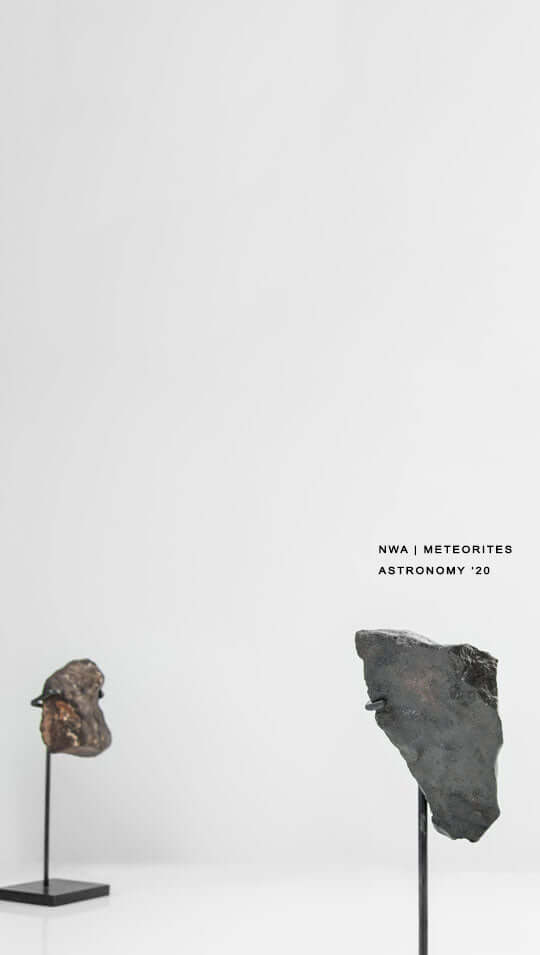Meteorite collecting has reached fever pitch over the last few decades, with the advent of more easily accessible routes to North Africa...
Shop the latest Meteorites For Sale

Luxury Meets the Extraterrestrial!
Meteorite collecting has reached fever pitch over the last few decades, with the advent of more easily accessible routes to North Africa. Post-war and through to ‘the road to Marrakech’ swinging sixties, the alternative travel destination bug has taken hold and in the wake of this influx of tourism, some intrepid meteorite collectors have taken the opportunity to reach and search the vast open territories of the northern deserts. An ideal meteorite collecting zone where strange space rocks have been impacting into the earth for centuries and may be collected in the continually shifting environment. It is estimated that up to seventy-five thousand meteorites fall to earth each year adding to the mass of the earth and it has been theorised this could have had an effect over billions of years and could account for the axis tilt of the planet.
Extraterrestrial stars form our ever-evolving solar system dating 4,500,000,000 [BILLION] years - presented on our custom AES stand series.
For thousands of years, man has found meteorites intriguing, the immense hardness and weight of some iron meteorites set them apart from any native terrestrial rocks of the earth. The hardness of these foreign bodies made them a valuable resource for specialised tool manufacture and possibly objects of veneration during periods of prehistory. In more recent times Europeans eager to traverse this vast Sahara seeking a wider understanding of nomadic life have recorded many prehistoric sites. These sites have also been noted by nomadic Berbers and Tuaregs, the indigenous peoples of the desert, they keenly observe the shifting sands and some of the more experienced meteorite hunters pluck from the desert floor anything that may prove profitable, of a prehistoric or meteorite nature. These finds are traded and filter through to the meteorite dealers of North Africa.
Meteorites penetrate our atmospheres at incredible speeds of up to 250,000km per hour. These show trauma evidence, a typical molten entry surface. Some meteorites break up in our atmosphere due to the immense heat factors and are reduced to a much smaller size. Meteorites of the Sahara polished by desert winds over long periods of time become buried, resurface and repeat the process and attain a patination which is often referred to as desert varnish. Some large meteorites bury deep into the earth crust on impact and may never have the same weathering. This desert varnish aids to identify NWA falls.
NWA Chondrite meteorites contain chondrules, originating from asteroids orbiting our solar system. Science can identify Chondrite meteorites which contain up to approximately twenty per cent of iron and nickel, microscopic-sized mineral spheres, known as Chondrules which are found in these stony-iron chondrites. Formed from molten particles of the solar nebula, by accumulation or coalescence, these particles merge to form asteroid belts, a small percentage of these occasionally falling to earth.
The Saharan Chondrite or stony Iron Chondrite meteorites are for the most part unclassified and so generally termed "Northwest Africa" meteorites. When these meteorites become classified, they are named Northwest African meteorites, abbreviated to NWA and this classification is followed by a number which denotes the fall, for example, NWA7034 is a meteorite reference of a fall originating from Mars. From the coasts of Mali in the west to the eastern Algerian Sahara finding authentic specimens can be fraught with pitfalls, often the unwary traveller is plied with lumps of rock which look like meteorites but are terrestrial and not celestial. There are tried and tested methods to identify the original from the bogus, such as a simple but effective strong neodymium magnet. These register the slightest amounts of iron deposits within some stony-iron meteorites.
However, a cautionary note is required here like a lump of slag iron weathered in the desert can look remarkably much like an alien rock! Some of the most valuable meteorites are non-ferrous, hence they are difficult to locate and identify a meteorite enthusiast could be duped. This is why meteorites are cut open or a slice is taken to identify the internal chemistry and match to known falls such as the lunar or Martian rocks brought back through space exploration. Experience and knowledge as always is the key or just let The Fossil Store take the strain and visit our catalogue to shop and buy authenticated superior meteorites with confidence.
Recently the most interesting and highly sort after meteorite types are the Lunar and Martian meteorites, these have been discovered from North Africa. The Tissint and NWA7034 are highly regarded and prised finds. In the last fifty years, Tissint has been the only witnessed Martian meteorite fall. NWA7034 is also the oldest known meteorite to have come from Mars and impact on terrestrial earth, and to make things more exciting it's a unique water-bearing regolith breccia type. What does this mean?... regolith is composed of foreign rock, iron and mineral fragments that are broken apart from underlying bedrock resulting from impact. Breccia is the term for rocks composed of bits and pieces of older rocks that have been consolidated together. A very interesting makeup for meteorite buffs. Learn more with us as our pages develop with the finds we cull from the territory NWA. Browse the 'Meteorite Collective' to see our latest Meteorites on THE FOSSIL STORE AES stands series.







